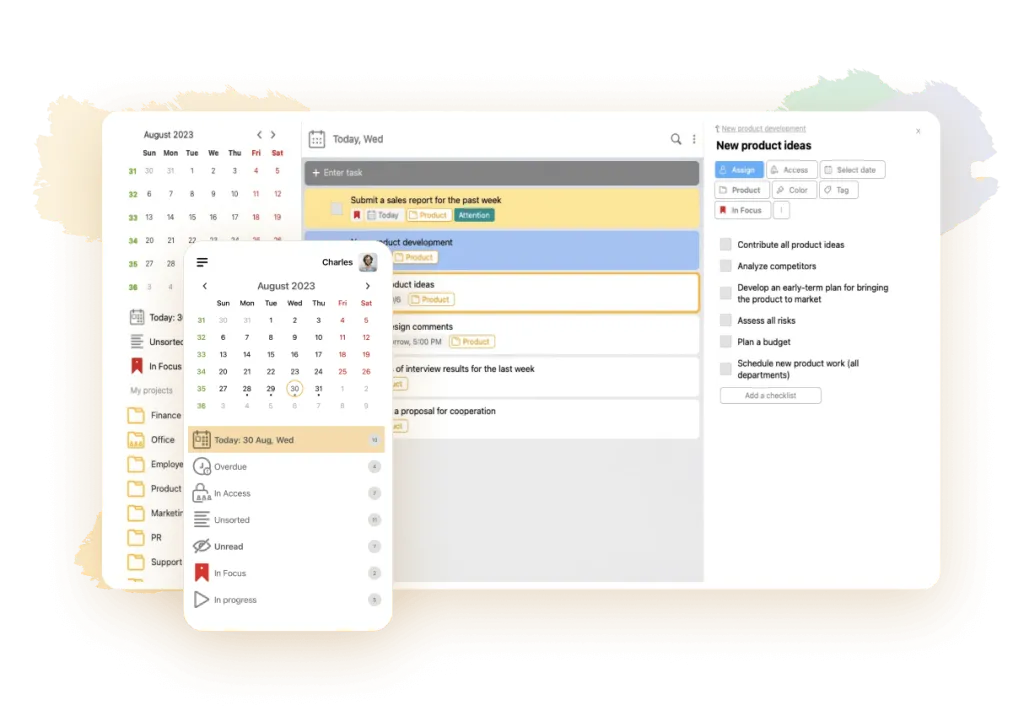
Max Miller
March 19, 2024
The success of any company depends on the efficient and well-coordinated work of its personnel. That is, the rapid, effective fulfillment of tasks within the established timeframe by each team member. But, often their fulfillment leaves much to be desired. Due to the inattention of employees to details, failure to meet deadlines or uneven distribution of assignments to performers, the work is slowed down and performed poorly.
A common cause of disputes with management is the lack of understanding of what stage each task is at and what adjustments need to be made to meet the deadline. Systematic monitoring of task fulfillment can help to solve this problem. It will help to organize the work of employees, increase their interest and involvement in the work process.
Why do you need task control
Clear, competent personnel control is beneficial for the management and the executors themselves. The company fulfills its goals, works successfully and fruitfully. Employees receive a large salary, the opportunity to quietly do their work without unnecessary workload and fuss.
Rational assigning tasks to employees and monitoring their performance helps:
-
timely detect “weaknesses” in the work process and quickly eliminate them;
-
to create a favorable environment in the team;
-
Improve employee productivity;
-
stabilize the company’s financial position;
-
prevent possible losses and damages due to failure to meet deadlines, other problems.
Control over employees should not become a totalitarian surveillance with the aim of identifying and punishing the guilty. Any innovations concerning work organization and planning should be perceived as cooperation. Work team members should realize that they will lead to the successful development of the company and the improvement of the well-being of its staff.
By controlling the work of the performers, you can:
-
Identify a decrease in motivation in a timely manner, understand the causes of this phenomenon.
-
Avoid uneven employee workloads.
-
Identify labor violators who demotivate the team.
-
Identify outsiders who have infiltrated the company for the purpose of espionage.
-
To uncover theft among employees.
For example, when installing GPS or tracking systems, staff should not perceive it as a fact of punishment or humiliation. It is important to explain the necessity of this measure for timely tracking of the results of assigned tasks, as failure to meet their deadlines, poor quality performance can have a negative impact on the company’s reputation.
Types of management control
Management control happens:
-
Selective. The supervisor decides when it is necessary to pay attention to an employee.
-
Periodic. Monitoring of personnel performance is performed at a certain frequency (e.g., once a week or every day).
-
Phased. It is applied as individual tasks are performed within the framework of the overall project. It helps to avoid many mistakes that hinder the realization of the set goals.
-
Preliminary. With step-by-step vetting of employees.
-
Final. It helps to evaluate an employee’s labor based on the results of the task assigned to him. The use of this method of assessment helps to improve motivation and stimulates personnel to self-development.
Many modern business processes are based on the Agile management methodology, which is based on control while maintaining flexibility in project planning and execution. Agile approach to doing business implies customer orientation. In this case, changes in the course of work execution are considered a natural phenomenon.
Personnel motivation is a key factor in the development of a company. Information is exchanged in the course of natural communication between employees. The result of fruitful and effective work in this case is a quality, working product.
These theses contradict the conservative management method practiced in some companies. However, the use of a flexible, integrated approach allows a business to react quickly and promptly to any changes occurring in the market.
The result of the implementation of this methodology is self-organizing, active teams that perform their tasks qualitatively and efficiently, and the absence of bureaucracy.

What the lack of systematic monitoring will lead to
No matter how well-paid and interesting a job may be, if there is no discipline, it eventually becomes routine. Knowing that no one will control the fulfillment of the task, employees “relax”, perform their duties “after hours”, distracted by personal matters or unimportant problems.
Lack of regular monitoring will result in the following consequences:
-
business process degradation;
-
of not honoring agreements;
-
deteriorating relationships with partners and customers;
-
inability to compete in the market with other companies.
Without employee monitoring, it is impossible to find out how well the hired specialists are doing their tasks. Even if an employee performs well at the interview stage, he may lack the skills or knowledge to take on more complex projects.
This also applies to management personnel. It is known that power has a negative effect on some managers, turning them into real “monsters”, unable to adequately assess the work of subordinates due to personal antipathy or other reasons, leading to the loss of valuable personnel by the company.
Controlling the activities of the company’s personnel will help prevent these and other problems. Employees will try to do their work quickly and efficiently, knowing that their actions are controlled and expecting to be rewarded for their labor. And the manager will be interested in getting the best result for the company and retaining valuable personnel.
Basic principles of control
The following control principles can be used to fully analyze the quality of task performance:
-
Adherence to deadlines. If an employee fails to meet a deadline, he must notify the manager in a timely manner.
-
Process Monitoring. Multi-step processes are divided into checkpoints or risk points where there is a high risk of loss or adverse consequences for the company. Work is monitored until these points occur.
-
Analysis of the results obtained. For this purpose, a list of tasks that need regular or periodic monitoring is drawn up, and appropriate conclusions are drawn based on their fulfillment. If it is found that at one and the same stage errors are constantly occurring due to the fault of one of the employees, the manager decides to delegate his authority or make changes in the workflow.
-
Automation of controlling processes using modern IT systems.
-
Deferred monitoring with data fixation. Allows you to return to the task solution after some time to make changes and adjustments.

Methods of control
Staff performance is monitored in an open manner, with feedback between subordinates and management. Various activities are used for this purpose, including:
-
Meetings and meetings. Short meetings of up to an hour, held daily, weekly or monthly, have the best effect.
-
Mystery Shopping methodology. It is used in trade and service organizations. Assesses the competence and professionalism of service personnel. Compliance with company standards is checked.
-
Technical control through video or audio surveillance systems. Using this method of surveillance, you can find out what the staff is doing at their workplaces. How responsibly employees treat their duties. How they behave towards customers.
-
Application of KPIs for employee labor evaluation. The set indicators should be realistic and achievable, motivating development to achieve better results.
-
Real-time monitoring. Used to assess the efficiency of working time utilization. Allows you to identify cases of unfair attitude to work. Avoid irrational spending of working time on watching entertainment content or “hanging out” on social networks.
In order to control task fulfillment in teams of 20 or more people, it is important to use special management systems that do not allow individual tasks to get lost in the general flow. Such as the popular LeaderTask scheduler suitable for small teams or creative teams, Asana operational management system and other programs that simplify work with individual and group tasks.
Errors in the organization of control
Even experienced and competent managers are not immune to mistakes in the organization of control of employees’ activities. These include:
-
Vague wording of goals and assignments.
-
Misunderstanding the nature of the workflow.
-
Uneven distribution of responsibilities.
-
“Overdoing” the supervisory function, leading to negativity from staff.
-
Disregard for intermediate results, devaluation of the labor of ordinary performers.
-
Lack of adequate response to identified problems, untimely elimination of detected deficiencies.
-
Improper use of the system of rewards and punishments. Constant criticism of personnel, leading to gradual “burnout” of employees.
-
A desire to please all subordinates.
-
“Hidden” control with sharp remarks when an employee’s mistakes are revealed, causing him to lose confidence and feel uncomfortable.
To prevent these and many other mistakes in company management, implementation of control automation programs will help. The use of these systems allows you to control the fulfillment of tasks in real time. Team members can make timely changes, attach files, documents, reports to tasks, and delegate tasks.
Automation of personnel control simplifies tasking of managers and team members working on joint projects. You should consider using task manager if:
-
Task deadlines lengthened for no apparent reason.
-
Some of the assignments go unnoticed.
-
Employees are overloaded with unnecessary work.
-
Most of the time is spent on monitoring their work.
-
Remote staff are present in the state.
Using automated tools to control tasks, you can prioritize them, tracking deadlines and the degree of completion. All files, documents and reports will be stored in one place. The executor will clearly see his algorithm of actions. It will be easier for him to understand what, when and how he should perform. And the manager will get an idea of how busy the employee is, whether he can handle the assignment or whether it needs to be redirected to another performer.
LeaderTask, a tool for monitoring employee task fulfillment

The LeaderTask program contains a set of tools that allow you to manage your employees in full. The application includes an assignment control system for assigning tasks. To organize proper teamwork, the task manager provides an electronic organizer.
Using LeaderTask’s electronic scheduler, you can unite your entire staff in one program, viewing each team member’s tasks in a timely manner. The application provides the following functions for the staff:
-
transfer overdue tasks to “Today” in automatic mode.
-
Tasks labeled with the name of the performer.
-
Statuses: “Pending”, “In Progress”, “Canceled”, “Ready for Delivery”.
The supervisor can take advantage of features such as:
-
Personal assignment of a task to a specific employee with the impossibility of its adjustment or modification by unauthorized persons. Once an order has been created, only the supervisor can make changes to it.
-
Checking of completed tasks with setting of statuses: “Completed” or “Finalization”.
-
Providing access to assignments.
-
Collaborative meetings with staff in group chat.
With the LeaderTask organizer, it’s easy to keep your tasks in order by categorizing them as “Unfiled”, “Unread”, or “Overdue”. Tasks can be sorted using the built-in filter.
The “task statuses” can be used to track an employee’s task completion. The manager will always be aware of what he is doing at the moment and which tasks have not yet been started.
Using the program simplifies the presence of voice input and synchronization functions on any device. You can create tasks and work in the application offline, without access to the Internet.
LeaderTask is a full-fledged employee management system that includes all the tools for control and functions for self-development of personnel. Each team member will always be aware of the tasks they need to accomplish by a certain deadline. And the manager will be able to easily control the quality of their fulfillment. Completed tasks can be viewed in real time.
Conclusion
Effective company management is impossible without controlling the activities of employees. This process can be simplified by organizing a full-fledged document flow in the company, evenly distributing the workload on the personnel, controlling the extent and quality of assigned tasks with the help of automated programs - schedulers and management systems.
All files, important documents, task data, will be focused in one system. You can open them at the right time. If necessary, make corrections. Using the data on the work performed, analyze it to make new management decisions.
Rational, competent control will give an accurate picture of the work of personnel, their competence, attitude to their duties. Using this information, it is possible to significantly improve the overall performance of the company, bringing it to a qualitatively new level in the future.








